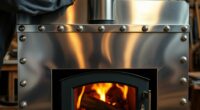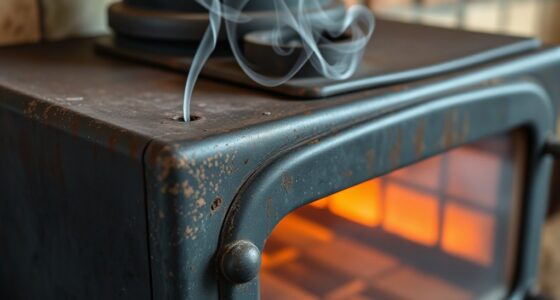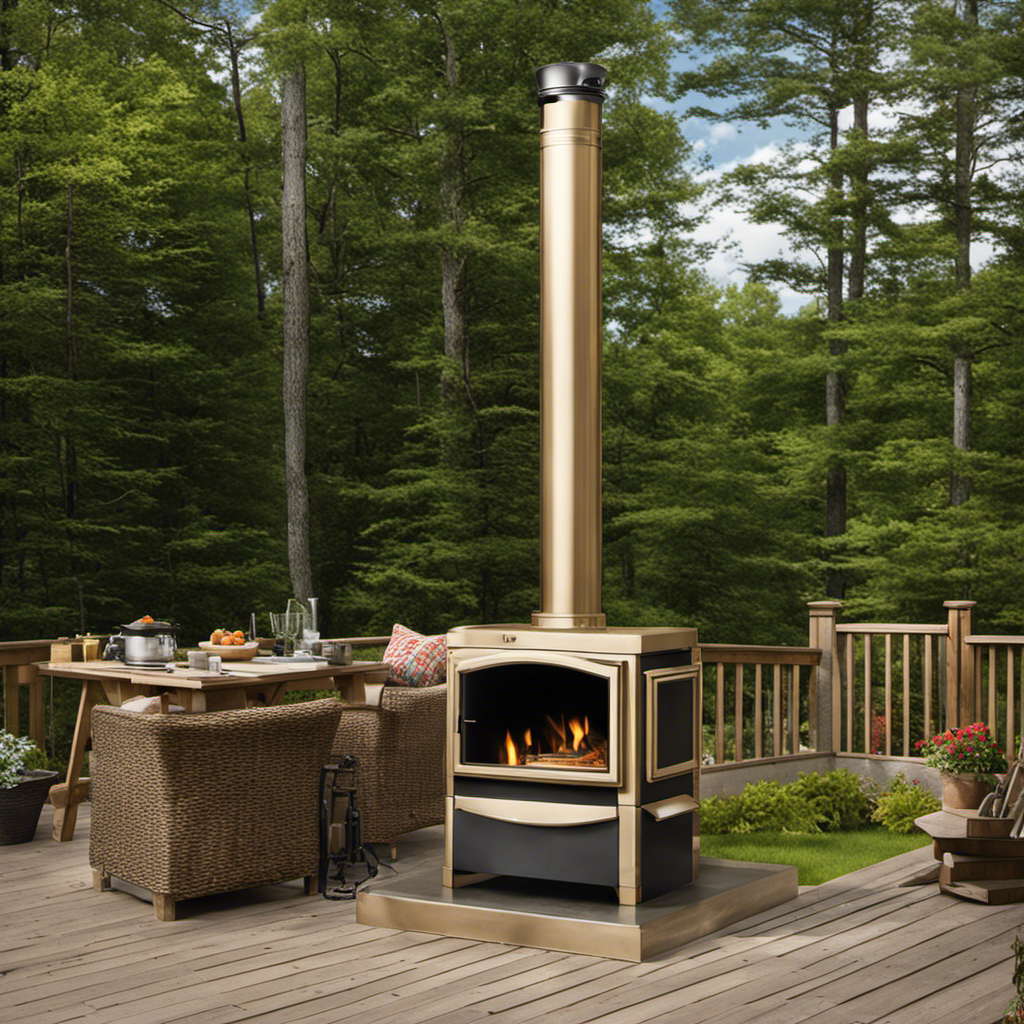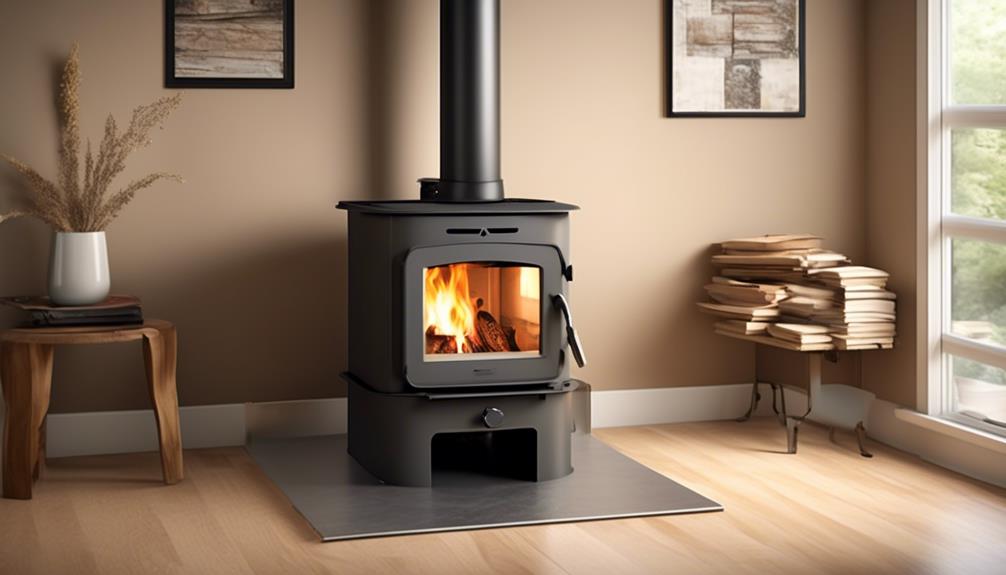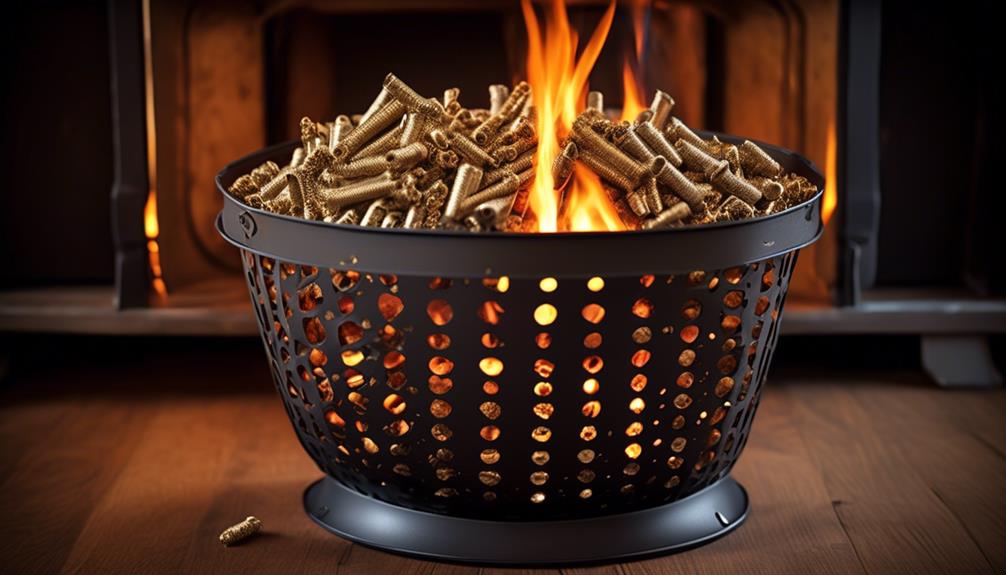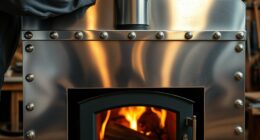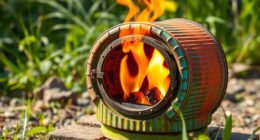When choosing between single-wall and double-wall stove pipes, consider your installation space, safety, and efficiency needs. Single-wall pipes are easier to install and good for short runs but heat up quickly and require careful clearance from combustibles. Double-wall pipes stay cooler, safer, and better for longer or more complex venting systems, though they are heavier and more complex to install. Making the right choice involves balancing ease of installation with safety, which you’ll discover more about as you explore your options.
Key Takeaways
- Single-wall pipe is easier to install and suitable for short, simple venting runs.
- Double-wall pipe provides better safety by staying cooler on the exterior and is ideal for longer or complex installations.
- Single-wall heats quickly and requires careful clearance from combustibles, while double-wall reduces fire risk.
- Double-wall offers improved heat retention and efficiency for venting larger or extended systems.
- Choose single-wall for small setups with space constraints, and double-wall for enhanced safety and performance in complex projects.

When selecting stove pipe for your heating system, understanding the differences between single-wall and double-wall options is essential. The choice impacts not only the efficiency of your stove but also important safety considerations like ventilation safety and the complexity of installation. Single-wall stove pipe is typically made from a single sheet of metal, usually steel or stainless steel, and is designed for straightforward installation. Because it’s thinner, it heats up quickly and is easier to handle during setup. However, its design requires careful attention to clearance distances because it heats intensely, which can pose risks if installed too close to combustible materials. Ventilation safety becomes a critical factor here—ensuring the pipe maintains proper clearance and is installed with appropriate shielding to prevent heat transfer is crucial. This makes single-wall pipe suitable for shorter runs or areas where space is limited, but it demands meticulous installation to avoid fire hazards.
Double-wall stove pipe, on the other hand, features an inner pipe surrounded by an insulating layer and an outer pipe, creating a double-layer construction. This design considerably improves ventilation safety because the outer wall stays cooler to the touch, reducing the risk of accidental burns or ignition of nearby combustibles. The insulation also helps maintain the efficiency of your stove by reducing heat loss, which can be a major advantage for larger or more extended venting runs. However, this benefit comes with increased installation complexity. Double-wall pipes are bulkier and heavier, requiring more precise fitting and sometimes additional components like insulated supports or special connectors. The installation process can be more time-consuming and may demand professional expertise to ensure all safety standards are met.
Choosing between these two types depends on your specific needs and circumstances. If you’re working with a small, simple setup where space is tight, single-wall pipe might be the practical choice, provided you follow proper clearance guidelines. For more complex or longer vent runs, or if safety and efficiency are top priorities, double-wall pipe offers superior ventilation safety and ease of handling in the long run, despite its more involved installation process. Ultimately, your decision should balance installation complexity against safety and performance. Remember, investing in the right stove pipe guarantees your heating system operates safely, efficiently, and reliably for years to come.
Frequently Asked Questions
Can Double-Wall Pipe Be Used for Outdoor Installations?
Yes, you can use double-wall pipe for outdoor installations. It offers better outdoor durability and insulation, protecting against weather elements. However, verify it meets ventilation requirements, as proper airflow is essential for safe operation. Double-wall pipe is often more resistant to rust and corrosion, making it a good choice outdoors. Always check your local building codes and manufacturer guidelines to confirm suitability for outdoor use.
How Do Installation Costs Compare Between Single-Wall and Double-Wall Pipe?
Imagine paying for a fancy suit versus a sturdy work shirt—installation costs differ similarly. Double-wall pipe usually costs more upfront due to its enhanced material durability and insulation, making installation pricier. Single-wall pipe is cheaper and simpler to install, but might not last as long. So, if you want long-term savings and durability, brace yourself for higher installation costs with double-wall pipe. Otherwise, go budget-friendly with single-wall options.
Are There Specific Codes Governing Double-Wall Stove Pipe Use?
You need to follow building codes and safety standards when using double-wall stove pipe. Local building codes often specify requirements for venting systems to guarantee safe operation, including clearance and material specifications. Safety standards set by organizations like the NFPA or the IRC help guarantee your installation minimizes fire risks and venting hazards. Always consult your local authorities or a professional installer to confirm your setup complies with these regulations.
How Does Pipe Thickness Affect Heat Retention and Safety?
Think of pipe thickness as the armor shielding your home’s warmth; thicker pipes trap heat like a cozy blanket, boosting insulation effectiveness. They also act as a barrier against fire risk, reducing the chance of sparks escaping. Conversely, thinner pipes may let heat escape and increase danger. To keep your home safe and warm, opt for the appropriate pipe thickness, balancing heat retention with fire safety.
Can Double-Wall Pipe Be Painted or Customized?
You can paint or customize double-wall pipe, but you should consider the painting options carefully. Use high-temperature or heat-resistant paints to avoid safety issues. Customization options might include color or decorative finishes, but guarantee the paint doesn’t compromise the pipe’s insulation or safety features. Always follow manufacturer guidelines and avoid covering vents or airflow paths. Proper preparation and selection of suitable paints allow you to personalize your stove pipe safely.
Conclusion
So, now that you know the differences between single-wall and double-wall stove pipes, which one feels like the right fit for your home? Remember, choosing the right pipe depends on safety, efficiency, and your specific setup. Don’t just settle for what’s easiest—consider what offers the best protection and performance. After all, isn’t a warm, safe home worth taking a moment to choose the best option? Your cozy space awaits, so make an informed decision today!


